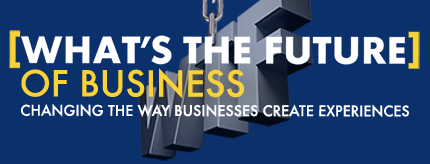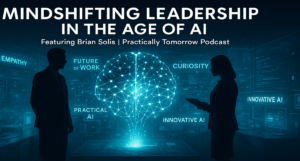There’s a lot of talk about the future of work…
Technology is indeed connecting us in ways that improve communication, discovery and connectivity. The world is becoming a much smaller place as a result. Chances are that you are connected in one network or another to people in at least 12 other countries. Although social networking and smartphones are relatively new as a staple in the everyday life of adults and kids, how we as consumers use these networks and devices is outpacing how we as employees use technology in the workplace. Over time, how we make decisions as consumers, what we come to expect from the companies that we do business with, and simply how we want to work with them is shifting the balance of power away from today’s business models to the connected masses.
Seems logical and almost commonsensical. The challenge however is that companies are anchored by decades or years of technology investments and the existing philosophies and processes that govern and support them today. But it doesn’t stop there. These connected customers though aren’t the only ones we need to understand, they also represent a growing percentage of our workforce.
Fighting Fire with Fire Will Only Burn Everything to the Ground
In my research, I’ve found that many executives are well aware of the onslaught of new technology. Many however, are unsure of how to solve the problem or even address what the problem really is for that matter. There are those in IT who are drafting new plans that alter long-established roadmaps to evaluate emergent social and mobile technologies. Some are bolting-on trendy technologies onto legacy systems to apply what will only prove to be a temporary fix. As my friend Stowe Boyd, a web anthropologist and futurist often says, “You can’t teach old tech new tricks.”
Either way, social and mobile threw a curveball. It wasn’t just because the technology overtook the world in a matter of a few short years, it’s that social media and mobile apps changed the behavior of people who use them. Suddenly businesses have to rethink…everything. Yet, how they’re structure today symbolizes an old guard of command and control approaches where employees use technology bestowed upon them because it was gospel. In today’s world though, all I can say is “good luck with that strategy.” More often than not, the technology we force onto people forces them to conform to a way of work dictated by technology and those who govern it within the organization rather than use technology as a seamless enabler to get work done, individually or collectively, the way that people organically use technology in their personal life.
Technology is most effective when it is invisible.
Throwing technology at the problem isn’t the answer. Technology is an enabler and we must see it for what it unlocks or facilitates. But that comes down to us not as information architects but as architects of collaboration and work to do something greater than what we accomplish today. With all of the hype, and fatigue, around new tech, it’s easy to get caught up in what’s hot and what’s next.
Technology is part of the solution but it’s also part of the problem.
In my research as a digital analyst and anthropologist, I explore the dynamics of human behavior from a bottom-up or escalation perspective. The conundrum facing IT and businesses overall, is that the philosophies and systems governing the way we work are traditionally designed from that of a top-down approach. Yet how we use technology in our real life is completely different than what we use or how we use it to get the job done.
Businesses can’t look at new tech as a solution until executives understand what it is they’re really trying to solve for or enable now and over time.
Intranets languish.
Knowledge sharing isn’t shared as much as businesses hoped.
Collaboration tools inhibit true collaboration.
Mobile access looks and feels nothing like the way our personal mobile apps feel and function.
So what’s the answer?
Social streams that allow people to feel like they’re tweeting inside their company?
Geo-location apps that allow them to check in to cafés or meeting rooms?
Facebook-like collaboration networks that allow employees to network and work with each other.
Shift to iOS and Android phones and tablets because you have to thanks to the momentum of employees + BYOD (bring your own device).
Cloud anything…because cloud!
Gamification rewards to incentivize people to use internal tech because they get points and there’s a leaderboard to show who’s winning?
It all sounds like it will work until of course, it doesn’t.
Why is that the case?
The answers are simple yet revealing…
When Technology Fails
When I study why technology fails to change behavior internally, the reasons always seem to surprise executives, but rarely do they shock employees.
1. Older managers disagree philosophically with how younger employees work in general.
2. Systems architects don’t get today’s employees.
3. Technology is too painful to use and there’s a lot of it.
4. Workflow is imposed rather than designed to emulate how people naturally use technology to communicate and connect.
5. Legacy processes and reporting systems actively discourage people to adopt something new.
6. Legacy philosophies protect those who work in dated paradigms rather than encourage aging workforces to gain new expertise through learning and collaboration.
7. Management doesn’t actually reward cross-team collaboration as part of the day-to-day work.
8. Incentives to change do not align with employee goals and aspirations.
9. Leadership does not lead by example.
10. A lack of vision as to why new technology will enable business goals and why employees should buy-in.
11. BONUS: The culture of the organization is more rigid than adaptive, which inadvertently undermines any hope for innovation
Depending on the culture of the organization, this list only grows…often unwieldy like a weed. Pulling the weed out buys time, but it grows back. You have to get to the root of the problem and solve for it as it lines up with the ultimate vision of the company. And sometimes, because things are so different now with market and employee behavior, that vision may need to be renewed or completely revised to mean something, to be relevant now and in the future.
Things must change, but change begins with seeing and approaching this challenge cum opportunity differently…
This is a time for leadership…not the conventional management systems as we know them. Change doesn’t have to come from today’s executives or managers however. What’s important to understand is that change can come from anywhere within the organization. Anyone can assume the role of leader as long as they have vision for what’s possible, courage to break what isn’t yet fully broken, and passion to mobilize people to unite in transformation. This sense of conviction is contagious and when approached with a human and business focus, even executives can’t help but listen…and learn. I guess that’s what this is about. We have to learn to learn again and that will only help us lead.
Connect with me…
Twitter | LinkedIn | Facebook | Google+ |Youtube | Instagram | Pinterest
Collaboration Image Credit: Shutterstock







Hi Brian,
Great article. I see number 1 most often…especially when it comes to social media. Older generations are astounded that people are so willing to be transparent, and they fail to see the value in it.
Which problem have you seen most often?
Josh
Thanks for the comment Josh. I see them all. Most importantly…most concerning…I’m not seeing the drive to train new employees for a new era of work.
Had I realized you were writing such a seminal piece that perfectly lays the foundation for what we are building with Alynd, I would have baked you a cake!
More seriously, there is another big picture problem here. The managers, the workers, the developers and even most thought leaders are only able to see one aspect of the problem at a time. They are unable to see how all of thee challenges are connected with each other and how their people are not only disconnected by the technology, but disconnected by purpose – that their interests are at odds with one another. Often times they are not only on different pages, they are on different planets!
The C-suite executive is focused on their large and powerful shareholders and what they think. The management layer is focused on growing one particular metric (nevermind how it hurts another manager’s metric, or destroys value or harms employee engagement in their all out pursuit of that result). The employee is focused on making their bosses happy and kissing their rear ends just so they get left alone, or perhaps get a hall pass to skip out on the tough work in gym class.
This is why we think it comes back to focusing on what is in everyone’s control – how two people work together effectively and efficiently to get something done. This is Alynd’s focus on what we call collaborative productivity – working smarter, together. Yes, it requires us to slow down just a bit to find clarity, so that we are on the same page. We need to focus our most precious resource, our time, on the things that matter most – tracking our commitments to others and their commitments to us. We need to gain control over our own workloads so we don’t over commit ourselves and we ensure we can produce the work that needs to be done, on time and as expected.
And in this way, we should earn the respect, recognition and rewards we deserve for the efforts we put forth and the outcomes we produce. The future of work is right around the corner, and I can’t wait to show you what we think it looks like and how much FUD, stress and waste we can remove when you are aligned with your colleagues – whether they sit inside your organization or outside of it…
There are a lot of other books that have pointed the way to a tangible solution like WTF, Connected Company, Work 2.0 and Speed of Trust to name a few. Perhaps it is another type of connection, the ones between all of this research, thinking and experience, that when put together in the proper context and viewed from the right perspective where we will not only find the future, but make it our every day reality. I’m really looking forward to showing you and all of our friends what we are building and why I am investing the rest of my life to helping people unleash their full potential in pursuit of their life’s purpose by rethinking about we work together to create value and get rid of the bullshit that is plaguing the work lives of way too many of us today.
This is why I’m not only a friend, but also a fan of your thinking…
Brian: great article. I am still shocked to see corporate leaders struggle with the idea of change; we change to get better, be more productive and successful. You also hit the bullseye with the lack of training or understanding of the benefits of collaboration which just gets down to being open to a new (better) way of doing business, new tech, new success. Embrace change! (before your competitors do…)
Well said Curtis!
Hopefully this helps too: http://www.altimetergroup.com/2014/07/the-2014-state-of-digital-transformation
Just one word about this piece. O U T S T A N D I N G
In true Brian Solis style and probably the most comprehensive analysis and insight into what is going on out there.
wow. wow. wow.
Brian, another good though provoking article. We need more CHANGE AGENTS like you in business. The reason people fear change is the unknown. They fear loss more than their desire for gain. “If you don’t like CHANGE in today’s business world, you’ll like IRRELEVANCE even more.
Thank you Blair. We need more people like us!
I’m off to buy your book. So much to think about in this post! Thanks.
Oh thank you!
Thanks, Brian. As long as the world of work is tied to financial rewards and those reward systems rewards dysfunction, dysfunction will continue. Example: where marketing historically owns the Brand and Sales owns the Customer. Marketing and Sales each pursue their goals in silos with little budgetary or organizational spill-over. In that all too common scenario, social business – social selling, social service, social collaboration – and the behavioral integration to support it – will be a challenge.
Great article, Brian… to me, this list seems to apply very much to big business, but do you think these points all apply equally to small business (and by small, I mean those with <50 employees)?
Hello George, I can’t say for certain as I haven’t formally studied it. However, I have looked informally at SMB and also the education sector. There are similarities indeed. However, it also depends on the industry…some are faster to adapt than others.
Thought provoking article. It would be interesting though, to know how these ideas apply to small businesses, which are and will be an important parcel of “the future of work”.